Recipes From ‘My Big Fat Greek Cookbook’: A Son’s Ode to His Mother’s Culinary Legacy
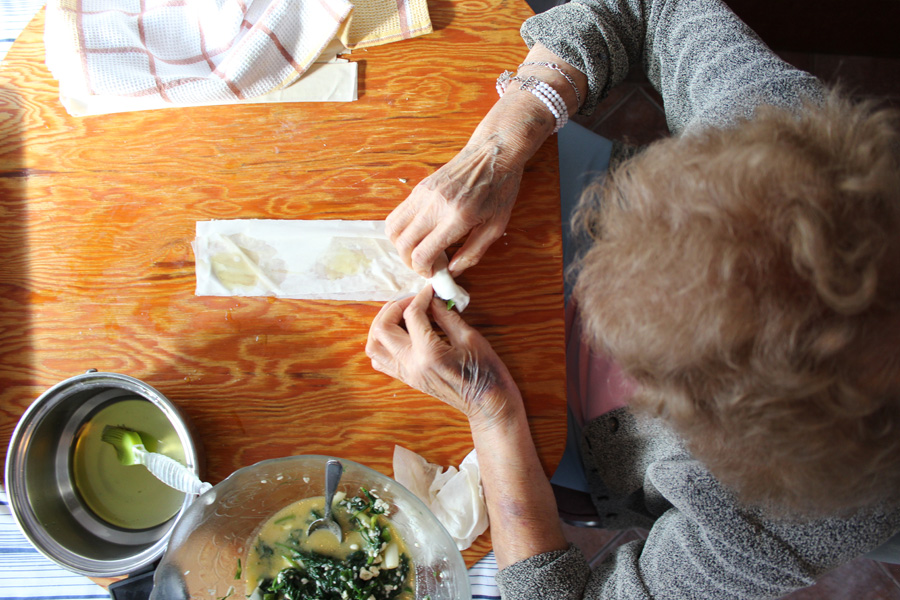
Evdokia Antginas making spanokopita. Photo courtesy of Christos Sourligas
As a child, Christos Sourligas knew better than to leave food on his plate at his mother’s table.
“My mom would always say, ‘That is your energy,’” the Montreal filmmaker, 49, recalls. “And so I grew up and, even to this day, I can’t waste food.”
In fact, for Sourligas’s mother, Evdokia Antginas, food represents much more than just a meal. In the early 1940s, during the Second World War, Antginas, still living in her native Greece, traversed the local Arcadian mountain ranges to bring meals to resistance fighters battling the Nazis. And when she later immigrated to Montreal, Antginas settled in the predominantly Greek neighbourhood of Park Extension where the proximity of stores and services in her native tongue meant that she only learned basic English.
As a result, food, Sourligas says, is, “probably my mom’s only language to the outside world, really … She just wanted to feed bellies. I remember friends in the 1980s and 1990s, up until a few years ago, they would literally starve themselves for days knowing that they were going to come to my parents’ place — I’m not joking — so they can have two or three plates of food to the point where their stomachs hurt them.”
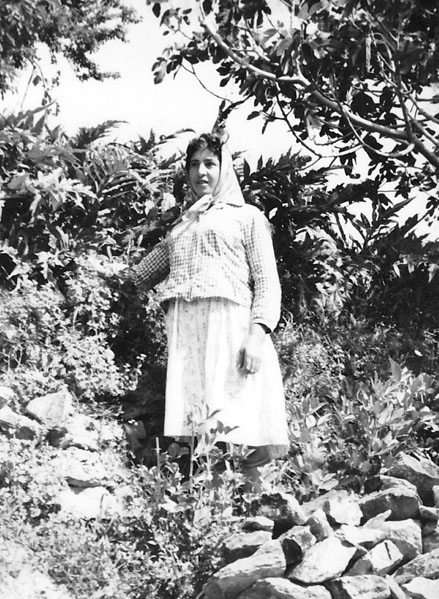
And that’s why, when doctors discovered Antginas, now 88, suffered from a heart ailment and gave her a diagnosis of 12 to 18 months to live, Sourligas decided to create a project that would pay homage to his mother’s legacy — one that revolves around food.
The result: My Big Fat Greek Cookbook: Classic Mediterranean Soul Food Recipes (available now) — a compendium of Antginas’s Arcadian recipes accompanied by the historical origins of some of the dishes and photos and stories from Antginas’s own life.
“My Big Fat Greek Cookbook is the antithesis of those trendy Mediterranean diets because most Greeks simply don’t eat that way. And certainly not the Greeks of the diaspora, which number more than 10 million people,” Sourligas writes in the book’s introduction. “We were brought up eating meat, stewed veggies, potatoes — big, hearty, simple meals from ingredients that my Mama grew or raised herself. Freshness and intense flavor [sic] are key in this book.”
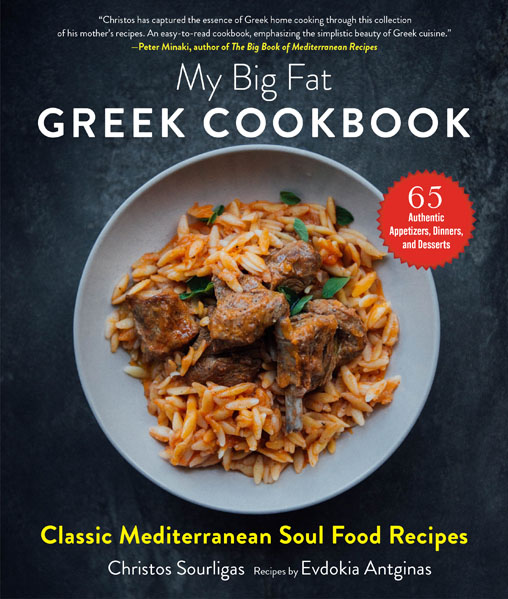
Sourligas worked alongside his mother, father and sister for more than a year to cook and document the recipes in My Big Fat Greek Cookbook — a priceless family experience to be sure. But soon came even better news: Antginas received a life-saving heart operation, and her family hopes she’ll be out of recovery and back home in the coming months.
Sourligas recently spoke with Zoomer about working with his mother on My Big Fat Greek Cookbook. And at the end of the interview, he provided two recipes from the book for Zoomer readers to try.
You’ve described Arcadian cuisine as harkening back to the romantic period and poets like Lord Byron.
CHRISTOS SOURLIGAS: Lord Byron is a huge figure in Greece. Besides being a romantic poet, he was actually one of the people who helped create the new independent state of Greece in 1821. And he died during the war. It was probably during the beginning of industrialization in Western Europe, and so they were trying to harken back to the old days of the simple shepherd life. And that’s what Arcadia is. Arcadianism is this idea of a bucolic life … It’s a very mountainous region and, because of that, unless you lived on the coast, they didn’t have access to the water. So you didn’t have access to fresh fish. So for them, it was sustenance based on the vegetables that they grew and the livestock that they had. So it’s very much meat and potatoes. And that’s why I call it legitimate rustic food, or soul food. And there’s a lot of actual vegetarian and vegan dishes as well.
What’s the earliest memory you have of your mother’s cooking?
CS: I remember this simple orange cake that I would just gobble down with glasses of cold milk [for breakfast]. She uses the orange and the actual orange zest, and I remember the top layer being this almost soft little blanket of love. Every time I eat that, it always rushes back to my earliest childhood — to when you were silly and young and naive and growing up as a product of immigrants and hanging out with other like-minded peers. I grew up in an area that’s mostly Greek and a lot of Italians as well. It is freedom. That’s kind of what it represented to me.
What did you learn about your mom’s cooking and about the food you’ve enjoyed your whole life while writing this book?
CS: Two things I learned. Some of these meals take a while so in between [waiting for the food to cook], I would Google to see where the origins of some of these dishes. Second — and this is the most important — [his family] never cooked with measuring instruments, cups and whatnot. I actually had to buy them; they didn’t have them in the house. And it took about half a year — I kid you not — to get them to actually cook with measuring cups. It’s all by taste, by feel — it becomes organic, like a part of their bodies. Sometimes she’d actually put her fingers inside and feel the actual temperature of some of the foods. She actually makes her yogurt by touch, by feeling how hot the actual yogurt is before she leaves it to cool off. I think it was something like if you could put your finger inside the milk and it can stay there for about 13 or 14 seconds before you feel like it’s burning, it’s right.
Did the food taste the same after incorporating exact measurements into the recipes?
CS: It’s funny you say that because I … hired a food stylist and a food photographer, and this food stylist probably made about eight of the dishes, and they tasted exactly like my mom’s. I was blown away. I felt like I was in my mom’s kitchen.
What was the experience like working with your mom on this book?
CS: It actually brought my mom and me closer, if you can believe it, because it was over a year in the making. And so I’d spend time with her — eight- to 10- or 12-hour days — that I hadn’t probably done since I was a child. And during a lot of that cooking, she would actually sing a lot of these old songs or read these old poems that she remembers off by heart, probably hundreds of them. And I would videotape them. So it was kind of our way to actually get closer. It was also kind of a way for me to say “I love you” and also be thankful to her … Our relationship got sweeter and softer for sure.
Recipes from My Big Fat Greek Cookbook
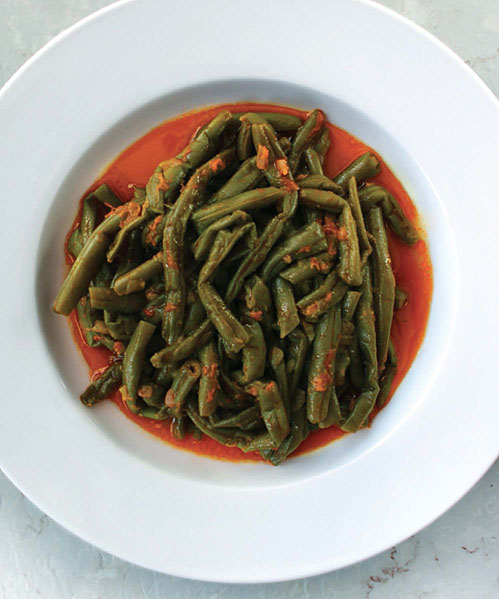
FASOLAKIA (green beans)
From the book: “Fasolakia heal whatever ails you. I love trimming green beans tips with my fingers. (Please don’t use a knife.) Feeling, stroking, touching — transferring your energy into your food — works, trust me. It’s like when you water your flowers, plants, vegetable gardens and herbs: always touch and talk to them. Because, just like children, we hope they will grow up to be wonderful and beautiful. And remember: fasolakia are made to be slurped back, so don’t feel embarrassed to do so. Just make sure to submerge your bread into the juicy broth for an extra kick. And feel free to crumble some feta on top for added taste.”
6 large handfuls green beans
2 celery tops and leaves (top half of celery stalks only)
1 medium onion
1 tbsp ground dry spearmint
1/2 cup olive oil
1/4 cup vegetable oil
1 tbsp salt
Pepper
1 cup tomato juice
Prep: 10 min
Cook: 1 h
Ready in: 1 h 10 min
Serves: 4
1. Wash all the vegetables. Trim the green bean tips. Chop the celery and onion into 1/2-inch cubes.
2. Sauté the onion with the olive and vegetable oils in a large stockpot for 3 to 5 minutes on high heat. Toss in the green beans, stir, then partially cover the pot. Cook for 5 minutes, then lower to medium-high heat.
3. Toss in the celery and spearmint. Stir and partially cover the pot. Cook for 10 minutes.
4. Mix in 3 cups of hot water from a boiling kettle. Cook for 15 minutes, stirring occasionally, making sure not to splinter the green beans.
5. Sprinkle in the salt and a dash of pepper, and add some additional hot water, if needed. Stir, partially covering the pot. Cook for another 15 minutes.
6. Pour in the tomato juice and stir the soft vegetables carefully. Cook for a final 15 minutes or until the water has evaporated and an orange, oily broth is left remaining. Remove from heat and allow to sit for 5 minutes before serving. Goes great with bread and feta cheese!
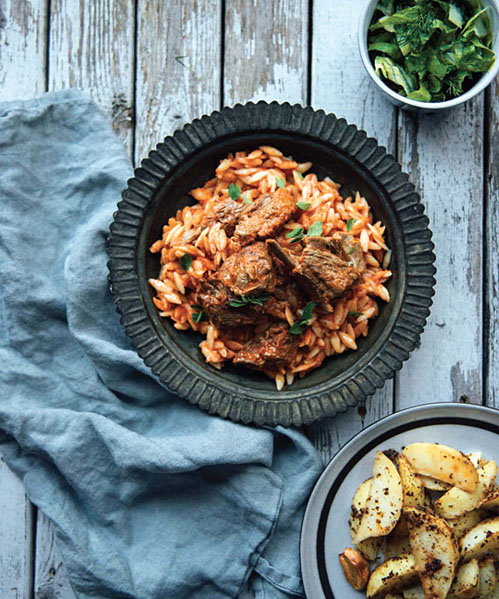
GIOUVETSI (giouvetsi)
From the book: “Giouvetsi epitomizes the simplicity of Greek peasant cuisine. Made up of just a few ingredients with a slow cooking and baking time, it’s hands-down my favorite Greek meat dish. Nothing beats giouvetsi on a cold winter night. It’s hearty, nourishing, soul-feeding, and I can’t have just one serving. I LOVE coating it with a massive amount of shredded cheese, as if a snowy, wintry blast just hit a bowl of meat … Yum!”
For the meat:
1.5 kg (3.3 lb) front shank veal (or chicken or lamb)
Salt (pinch)
White vinegar (sprinkle)
2 medium onions
1 tbsp olive oil
2 tbsp vegetable oil
1/2 cup tomato juice
1/2 tbsp salt
1/4 tsp pepper
For the pasta:
2 cups kritharaki (orzo pasta) — or hilopites or spaghetti
1/2 cup tomato juice
Romano cheese
Prep: 10 min
Cook and bake: 2 h 20 min
Ready in: 2 h 30 min
Serves: 6
1. Cut the veal into 2-inch cubes; do not debone. In a large stockpot, pour in sufficient water to cover the meat. Toss in 2 or 3 dashes of salt and drizzle in a touch of vinegar. Boil for 10 minutes. Skim the froth with a slotted spoon, then remove the meat and place into a bowl. Rinse out the pot.
2. Pour the olive and vegetable oils into the stockpot. Chop the onions into 1/2-inch cubes, toss in, and sauté over medium-high heat. Add in the veal cubes and cover the meat with hot water from a boiling kettle. Partially cover the pot and stir. Bring the pot to a boil, then lower to medium-high heat. Feed the pot with boiling water, if needed. Continue cooking for 45 minutes, then mix in the tomato juice, salt and pepper. Stir, partially covering the pot, and cook for another 10 minutes. Set aside.
3. Preheat the oven to 395 F (200 C).
4. Add the kritharaki into a large baking dish (ideally, a round clay baking dish) spreading the pasta around with your fingers. Mix in 4 cups of hot water from a boiling kettle and bake. Stir occasionally, making sure the kritharaki doesn’t stick to the dish, while allowing the pasta and water to reach a boil (about 15 minutes). Then, mix in the tomato juice, and combine the veal and its broth. Bake for 10 minutes. Turn off the heat, and let the giouvetsi stand in the oven for an additional 10 minutes or until the pasta thickens.
5. Remove from oven. Let cool, then top with grated Romano cheese. Serve with bread and red wine.
My Big Fat Greek Cookbook: Classic Mediterranean Soul Food Recipes is available now, in stores and online.
A version of this story was originally published on Oct. 30, 2019